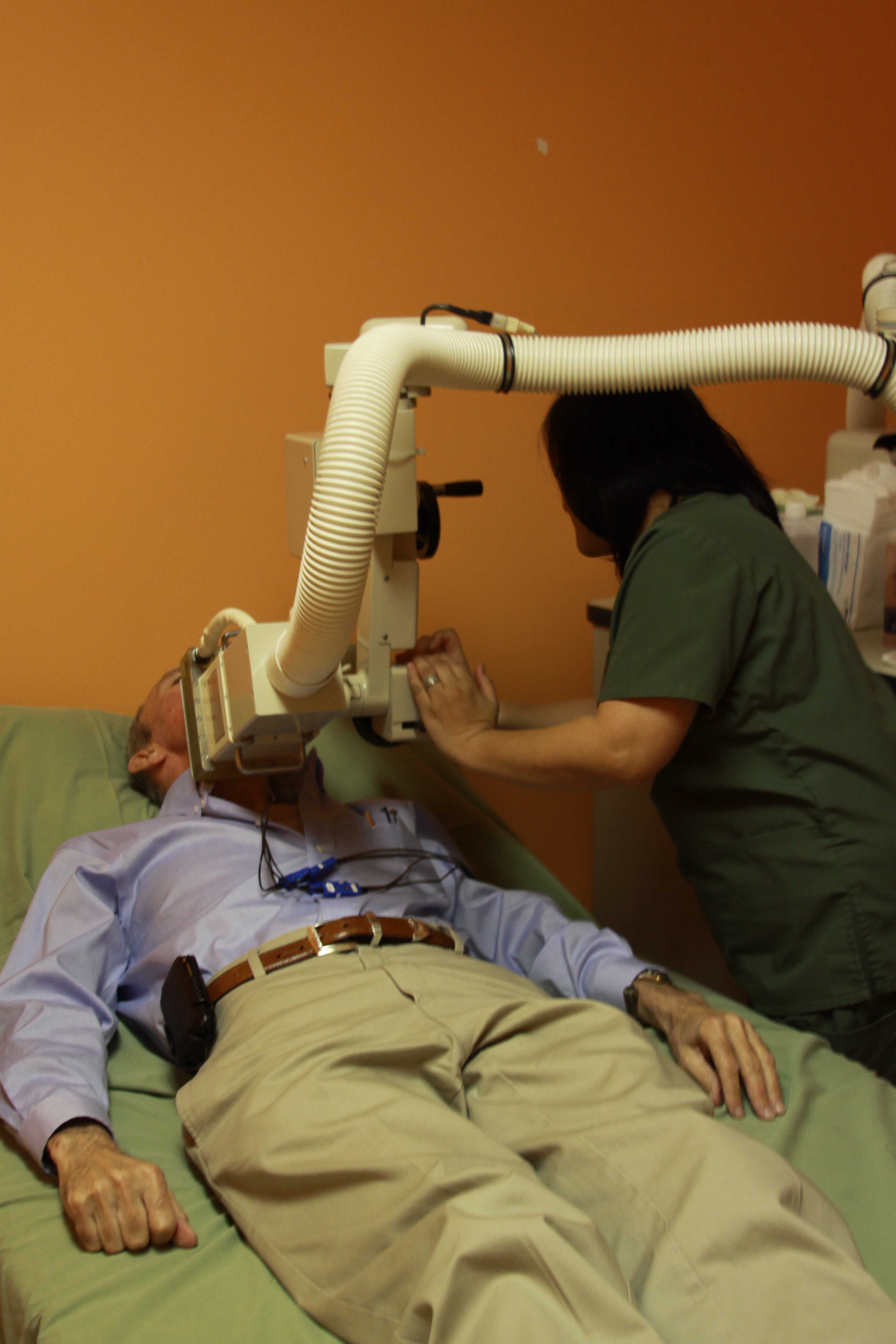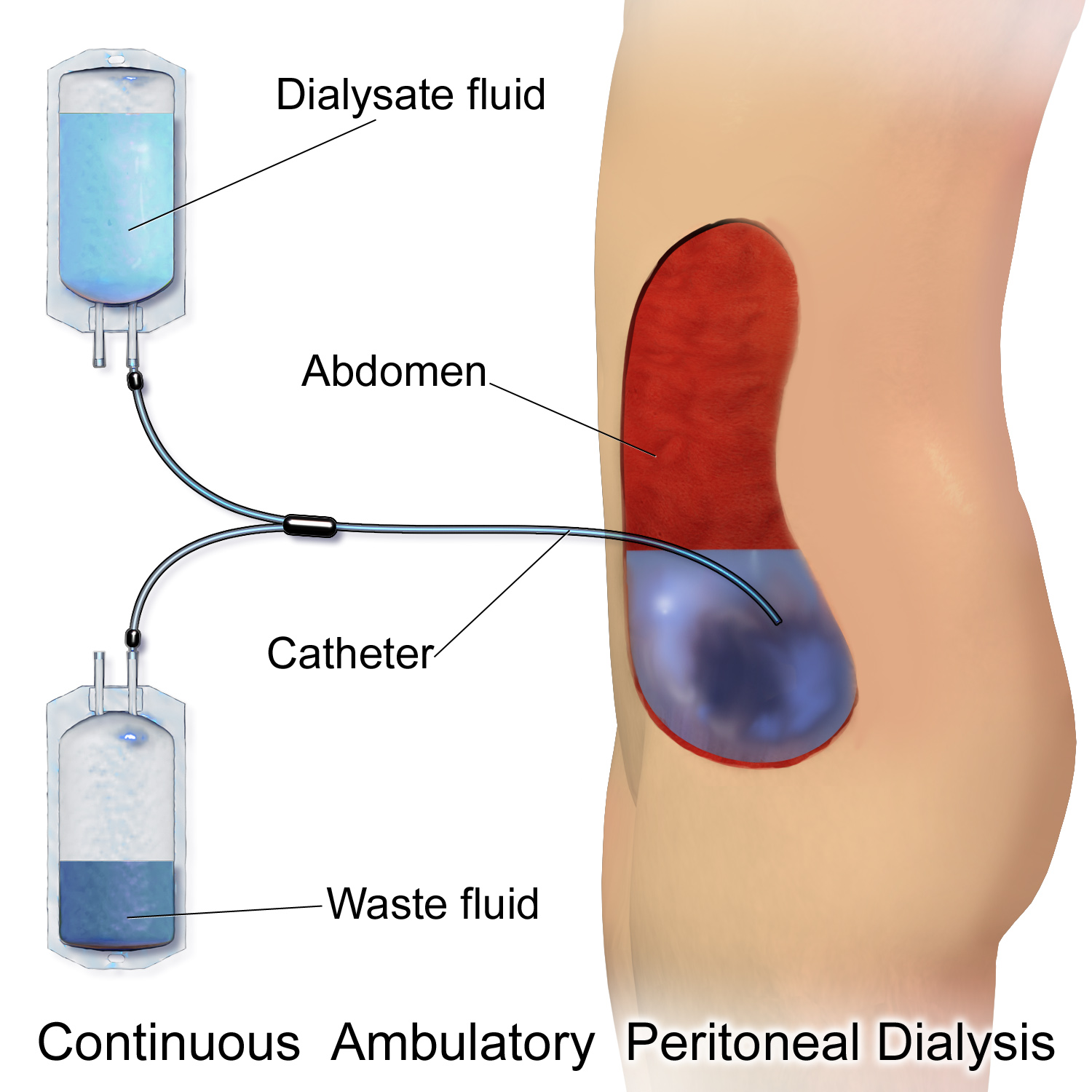|
Hyperthermic Intraperitoneal Chemotherapy
Intraperitoneal hyperthermic chemoperfusion (HIPEC or IPHC) is a type of hyperthermia therapy used in combination with surgery in the treatment of advanced abdominal cancers. In this procedure, warmed anti-cancer medications are infused and circulated in the peritoneal cavity (abdomen) for a short period of time. The chemotherapeutic agents generally infused during IPHC are mitomycin-C and cisplatin. Medical uses IPHC is generally used after surgical removal of as much cancer as possible (debulking), which may include the removal of all involved peritoneal areas. Evidence supports a benefit in certain cases of ovarian cancer. Evidence is insufficient as of 2020 to support its use in primary advanced epithelial ovarian, fallopian tube or primary peritoneal carcinoma, recurrent ovarian cancer, peritoneal colorectal carcinomatosis, gastric peritoneal carcinomatosis, malignant peritoneal mesothelioma, or disseminated mucinous neoplasm of the appendix. These procedures can be 8–10 ... [...More Info...] [...Related Items...] OR: [Wikipedia] [Google] [Baidu] |
Hyperthermia Therapy
Hyperthermia therapy ''(or hyperthermia, or thermotherapy)'' is a type of medical treatment in which body tissue is exposed to temperatures above body temperature, in the region of 40–45 °C (104–113 °F). Hyperthermia is usually applied as an adjuvant to radiotherapy or chemotherapy, to which it works as a sensitizer, in an effort to treat cancer. Hyperthermia uses higher temperatures than diathermy and lower temperatures than ablation. When combined with radiation therapy, it can be called thermoradiotherapy. Definition Hyperthermia is defined as supra-normal body temperatures. There is no consensus as to what is the safest or most effective target temperature for the whole body. During treatment the body temperature reaches a level between . However, other researchers define hyperthermia between (Europe, USA) to near (Japan, Russia). Types * ''Local hyperthermia'' heats a very small area and is typically used for cancers near or on the skin or near natu ... [...More Info...] [...Related Items...] OR: [Wikipedia] [Google] [Baidu] |
Mucinous Neoplasm Of The Appendix
Appendix cancer are very rare cancers of the vermiform appendix. Gastrointestinal stromal tumors are rare tumors with malignant potential. Primary lymphomas can occur in the appendix. Breast cancer, colon cancer, and tumors of the female genital tract may metastasize to the appendix. Diagnosis Carcinoid tumors are the most common tumors of the appendix. Other common forms are mucinous adenocarcinomas, adenocarcinoma not otherwise specified (NOS), and signet ring cell adenocarcinoma listed from highest to lowest incidence. Carcinoid A carcinoid is a neuroendocrine tumor (NET) of the intestines. Incidence rates among carcinoids occur at about .15 per 100,000 per year. This subgroup makes up a large amount of neoplasias both malignant and benign. Almost 3 out of 4 of these tumors are associated with the region at the end of the appendix, and tend to be diagnosed in the 4th to 5th decades in life. Both women and Caucasian individuals show a minor prevalence regarding Neuroendocrine ... [...More Info...] [...Related Items...] OR: [Wikipedia] [Google] [Baidu] |
Overhydration
Water intoxication, also known as water poisoning, hyperhydration, overhydration, or water toxemia, is a potentially fatal disturbance in brain functions that results when the normal balance of electrolytes in the body is pushed outside safe limits by excessive water intake. Under normal circumstances, accidentally consuming too much water is exceptionally rare. Nearly all deaths related to water intoxication in normal individuals have resulted either from water-drinking contests, in which individuals attempt to consume large amounts of water, or from long bouts of exercise during which excessive amounts of fluid were consumed. In addition, water cure, a method of torture in which the victim is forced to consume excessive amounts of water, can cause water intoxication. Water, just like any other substance, can be considered a poison when over-consumed in a brief period of time. Water intoxication mostly occurs when water is being consumed in a high quantity without adequate ele ... [...More Info...] [...Related Items...] OR: [Wikipedia] [Google] [Baidu] |
Goal-directed Therapy
Early goal-directed therapy (GDT) was introduced by Emanuel P. Rivers in ''The New England Journal of Medicine'' in 2001 and is a technique used in critical care medicine involving intensive monitoring and aggressive management of perioperative hemodynamics in patients with a high risk of morbidity and mortality. In cardiac surgery, goal-directed therapy has proved effective when commenced after surgery. The combination of GDT and Point-of-Care Testing has demonstrated a marked decrease in mortality for patients undergoing congenital heart surgery. Furthermore, a reduction in morbidity and mortality has been associated with GDT techniques when used in conjunction with an electronic medical record. Early goal-directed therapy is a more specific form of therapy used for the treatment of severe sepsis and septic shock. This approach involves adjustments of cardiac preload, afterload, and contractility to balance oxygen delivery with an increased oxygen demand before surgery. Three t ... [...More Info...] [...Related Items...] OR: [Wikipedia] [Google] [Baidu] |
Peritoneal Dialysis
Peritoneal dialysis (PD) is a type of dialysis which uses the peritoneum in a person's abdomen as the membrane through which fluid and dissolved substances are exchanged with the blood. It is used to remove excess fluid, correct electrolyte problems, and remove toxins in those with kidney failure. Peritoneal dialysis has better outcomes than hemodialysis during the first couple of years. Other benefits include greater flexibility and better tolerability in those with significant heart disease. Complications may include infections within the abdomen, hernias, high blood sugar, bleeding in the abdomen, and blockage of the catheter. Use is not possible in those with significant prior abdominal surgery or inflammatory bowel disease. It requires some degree of technical skill to be done properly. In peritoneal dialysis, a specific solution is introduced through a permanent tube in the lower abdomen and then removed. This may either occur at regular intervals throughout the day, kn ... [...More Info...] [...Related Items...] OR: [Wikipedia] [Google] [Baidu] |
Paul Sugarbaker
Paul Hendrick Sugarbaker (born November 28, 1941, in Baltimore) is an American surgeon at the Washington Cancer Institute. He is known for developments in surgical oncology of the abdomen, including cytoreductive surgery followed by hyperthermic intraperitoneal chemotherapy, or HIPEC, a treatment alternately referred to as the Sugarbaker Procedure. Sugarbaker is the elder brother of the surgeon David Sugarbaker. Sugarbaker attended high school in Jefferson City, Missouri and received a bachelor's degree from Wheaton College in Illinois in 1963. In 1967 he graduated from the medical college at Cornell University. He interned and did his residency at Peter Bent Brigham Hospital in Boston, serving as chief resident from 1973 to 1976. From 1976 to 1986, he spent ten years at the National Cancer Institute–Surgery Branch of the National Institutes of Health in Bethesda, Maryland, as Senior Investigator. He was also head of surgical oncology at Emory University Medical School, and ... [...More Info...] [...Related Items...] OR: [Wikipedia] [Google] [Baidu] |
Joe Vincent Meigs
Joe Vincent Meigs (October 24, 1892, Lowell, Massachusetts – October 24, 1963), was an American obstetrician and gynecologist. Meigs was a grandson of Captain Joe Vincent Meigs, who invented an experimental steam monorail known as the Meigs Elevated Railway, Meigs single-track elevated railroad. Meigs syndrome is named after him. See also * Mary Ann Vincent References External links * 1892 births 1963 deaths American obstetricians American gynecologists {{US-physician-stub ... [...More Info...] [...Related Items...] OR: [Wikipedia] [Google] [Baidu] |
Oxaliplatin
Oxaliplatin, sold under the brand name Eloxatin among others, is a cancer medication (platinum-based antineoplastic class) used to treat colorectal cancer. It is given by injection into a vein. Common side effects include numbness, feeling tired, nausea, diarrhea, and low blood cell counts. Other serious side effects include allergic reactions. Use in pregnancy is known to harm the baby. Oxaliplatin is in the platinum-based antineoplastic family of medications. It is believed to work by blocking the duplication of DNA. Oxaliplatin was patented in 1976 and approved for medical use in 1996. It is on the World Health Organization's List of Essential Medicines. Medical uses Oxaliplatin is used for treatment of colorectal cancer, typically along with folinic acid (leucovorin) and fluorouracil in a combination known as FOLFOX or along with capecitabine in a combination known as CAPOX or XELOX. Advanced colorectal cancer Oxaliplatin by itself has modest activity against adv ... [...More Info...] [...Related Items...] OR: [Wikipedia] [Google] [Baidu] |
Mitomycin C
Mitomycin C is a mitomycin that is used as a chemotherapeutic agent by virtue of its antitumour activity. Medical uses It is given intravenously to treat upper gastro-intestinal cancers (e.g. esophageal carcinoma), anal cancers, and breast cancers, as well as by bladder instillation for superficial bladder tumours. Mitomycin C has also been used topically rather than intravenously in several areas. The first is cancers, particularly bladder cancers and intraperitoneal tumours. It is now well known that a single instillation of this agent within 6 hours of bladder tumor resection can prevent recurrence. The second is in eye surgery where mitomycin C 0.02% is applied topically to prevent scarring during glaucoma filtering surgery and to prevent haze after PRK or LASIK; mitomycin C has also been shown to reduce fibrosis in strabismus surgery. The third is in esophageal and tracheal stenosis where application of mitomycin C onto the mucosa immediately following dilatation ... [...More Info...] [...Related Items...] OR: [Wikipedia] [Google] [Baidu] |
Hyperthermic Intrathoracic Chemotherapy
Hyperthermic intrathoracic chemotherapy (HITOC) is part of a surgical strategy employed in the treatment of various pleural malignancies. The pleura in this situation could be considered to include the surface linings of the chest wall, lungs, mediastinum, and diaphragm. HITOC is the chest counterpart of HIPEC. Traditionally used in the treatment of malignant mesothelioma, a primary malignancy of the pleura, this modality has recently been evaluated in the treatment of secondary pleural malignancies (e.g. thymic tumors, secondary pleural carcinosis). Metastases to the pleural surface from any primary tumor represents Stage IV disease which carries in general an extremely poor prognosis. In addition; in highly selected situations the pleura can be involved by local spread or “seeding” from thoracic tumors such as lung, esophageal, and thymic cancers. Secondary pleural malignancies include metastasis from distant primary tumors including breast, colon, ovarian, uterine and ... [...More Info...] [...Related Items...] OR: [Wikipedia] [Google] [Baidu] |
Carcinomatosis
Carcinosis, or carcinomatosis, is disseminated cancer, forms of metastasis, whether used generally or in specific patterns of spread. Usage Carcinomatosis is often restricted to tumors of epithelial origin, adenocarcinomas, while sarcomatosis describes the dissemination of tumors of mesenchymal origin, sarcomas. Lung Lymphangitic carcinomatosis When most tumors metastasize to the lung, they form distinct nodules, but about 7% spread through the lymph vessels of the lung. They may impair breathing in several ways; the lung becomes stiffer; blood vessels traveling alongside the distended lymph vessels become compressed. Miliary carcinosis A pattern of multiple small nodular metastases has been described as miliary carcinosis which has a radiographic appearance similar to miliary tuberculosis. Body cavities Any potential space may be seeded with tumor cells that grow along surfaces, but which may not invade below the surfaces. In rare cases, the joint spaces are affected. Peritone ... [...More Info...] [...Related Items...] OR: [Wikipedia] [Google] [Baidu] |
Theodore Lawrence
Theodore Steven Lawrence is an American radiation oncologist. In 2015, Lawrence was appointed the director of the University of Michigan Rogel Cancer Center. Early life and education Lawrence was born in Queens, New York but raised in Port Washington, New York on Long Island. After graduating from Paul D. Schreiber Senior High School Lawrence enrolled at Rockefeller University for his PhD and Cornell University for his medical degree. With his medical degree, Lawrence then completed his residency in internal medicine at Stanford University and National Cancer Institute. Career Upon completing his residency, Larence joined the faculty at the University of Michigan in 1987. During his early tenure at the institution, he developed combined treatments of intensified chemotherapy and radiation for patients with pancreatic cancer. He was soon promoted to the rank of associate professor of radiation oncology and interim chair of the Department of Radiation Oncology. In 2007, Larence was r ... [...More Info...] [...Related Items...] OR: [Wikipedia] [Google] [Baidu] |




